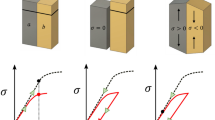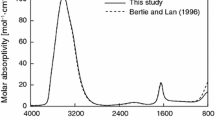Summary
An asymmetric ESR signal and an outer doublet signal centered atg=2.00 produced in human tooth enamel by X-irradiation have been studied over a temperature range from liquid helium temperature to 380° K. The line shape of the asymmetric signal for an enamel crystallite is Lorentzian at room temperature. The temperature dependence of the integrated intensity of the asymmetric signal suggests that the signal follows a singlet-triplet model with the exchange interaction of 0.022 eV. Below about 60° K the asymmetric signal becomes broad as the temperature is decreased. The ENDOR line of the asymmetric signal shows that there exists interaction between the centers and protons. The temperature dependence of the integrated intensity of the double signal is analogous to that of the asymmetric signal.
Similar content being viewed by others
References
Ostrowski, K., Dziedzic-Goclawska, A., Stachowicz, W., Michalik, J.: Accuracy, sensitivity, and specificity of electron spin resonance analysis of mineral constituents of irradiated tissues, Ann. N.Y. Acad. Sci.238:186–201, 1974
Stachowicz, W., Ostrowski, K., Dziedzic-Goclawska, A., Komender, A.: ESR study of bone tissue sterilized by gamma irradiation, Nukleonika15:131–142, 1970
Houben, J.L.: Free radicals produced by ionizing radiation in bone and its constituents, Int. J. Radiat. Biol.20:373–389, 1971
Cevc, P., Schara, M., Ravnik, C.: Electron paramagnetic resonance study of irradiated tooth enamel, Radiat. Res.51:581–589, 1972
Peckauskas, R.A., Pullman, I.: Radiogenic free radicals as molecular probes in bone, Calcif. Tissue Res.25:37–43, 1978
Wyard, S.J.: Double integration of electron spin resonance spectra, J. Sci. Instrum.42:769–770, 1965
Glas, J.E.: Studies on the ultrastructure of dental enamel. II. The orientation of the apatite crystallites as deduced from X-ray diffraction, Arch. Oral Biol.7:91–104, 1962
Ibers, J.A., Swalen, J.D.: Paramagnetic resonance line shapes and magnetic parameters of polycrystalline substances, Phys. Rev.127:1914–1917, 1962
Atkins, P.W., Symons, M.C.R.: The Structure of Inorganic Radicals. Elsevier, Amsterdam, 1967
Bijl, D., Kainer, H., Rose-Innes, A.C.: Biradical molecular compounds: a study by electron spin resonance, J. Chem. Phys.30:765–770, 1959
Prener, J.S., Piper, W.W., Chrenko, R.M.: Hydroxide and oxide impurities in calcium halophosphates, J. Phys. Chem. Solids30:1465–1481, 1969
Author information
Authors and Affiliations
Rights and permissions
About this article
Cite this article
Sato, K. Study of an asymmetric ESR signal in X-irradiated human tooth enamel. Calcif Tissue Int 29, 95–99 (1979). https://doi.org/10.1007/BF02408063
Received:
Revised:
Accepted:
Issue Date:
DOI: https://doi.org/10.1007/BF02408063




